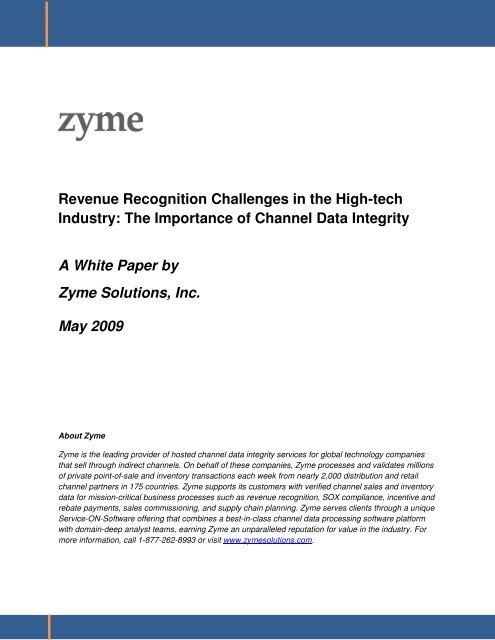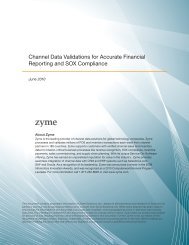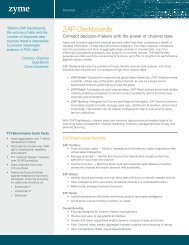Whitepaper Explaining the Fundamentals of Channel Data Management
Channel data management is a solution that enables companies who want to transform their channel into the 'New Smart Channel'. Go through this whitepaper to know how Zyme Solutions serves clients through a unique Service-ON-Software offering that combines a best-in-class channel data processing software platforms. See more at: http://www.zyme.com/channel-data-management
Channel data management is a solution that enables companies who want to transform their channel into the 'New Smart Channel'. Go through this whitepaper to know how Zyme Solutions serves clients through a unique Service-ON-Software offering that combines a best-in-class channel data processing software platforms. See more at: http://www.zyme.com/channel-data-management
Create successful ePaper yourself
Turn your PDF publications into a flip-book with our unique Google optimized e-Paper software.
Revenue Recognition Challenges in <strong>the</strong> High-tech<br />
Industry: The Importance <strong>of</strong> <strong>Channel</strong> <strong>Data</strong> Integrity<br />
A White Paper by<br />
Zyme Solutions, Inc.<br />
May 2009<br />
About Zyme<br />
Zyme is <strong>the</strong> leading provider <strong>of</strong> hosted channel data integrity services for global technology companies<br />
that sell through indirect channels. On behalf <strong>of</strong> <strong>the</strong>se companies, Zyme processes and validates millions<br />
<strong>of</strong> private point-<strong>of</strong>-sale and inventory transactions each week from nearly 2,000 distribution and retail<br />
channel partners in 175 countries. Zyme supports its customers with verified channel sales and inventory<br />
data for mission-critical business processes such as revenue recognition, SOX compliance, incentive and<br />
rebate payments, sales commissioning, and supply chain planning. Zyme serves clients through a unique<br />
Service-ON-S<strong>of</strong>tware <strong>of</strong>fering that combines a best-in-class channel data processing s<strong>of</strong>tware platform<br />
with domain-deep analyst teams, earning Zyme an unparalleled reputation for value in <strong>the</strong> industry. For<br />
more information, call 1-877-262-8993 or visit www.zymesolutions.com.
Executive Overview<br />
High-tech companies that sell through indirect channels face many challenges when deciding<br />
on a revenue recognition policy. They must comply with regulations, ensure access to accurate<br />
and timely channel sales data, and maintain robust systems and processes that support<br />
revenue accounting. Company finance departments need to evaluate <strong>the</strong> pros and cons <strong>of</strong> <strong>the</strong><br />
“sales-in” vs. “sales-out” approach for revenue recognition. While <strong>the</strong> sales-out approach is<br />
considered to be more conservative, and may benefit companies by leading to lower required<br />
reserves, it poses implementation challenges because it is dependent on self-reported<br />
distributor information and lacks because <strong>the</strong> company lacks control over information accuracy.<br />
Transitioning from a sales-in to a sales-out approach is a significant effort, but one that can be<br />
managed by systematically on-boarding channel partners, consolidating and validating partners’<br />
point-<strong>of</strong>-sale (POS) and inventory data, and using a compliance scorecard to ensure timeliness<br />
and data quality. Partner compliance in providing timely and accurate POS and inventory data<br />
enables companies to perform an accurate reconciliation <strong>of</strong> sales-in vs. sales-out data. Such<br />
data forms <strong>the</strong> basis <strong>of</strong> inventory valuation, while rigorous monitoring <strong>of</strong> variances between<br />
calculated and reported inventory can provide valuable insights.<br />
Background<br />
The technology industry has a complex, global, multi-tier distribution channel, and continuous<br />
technological innovation, which drives short product lifecycles and constant price pressure. Due<br />
to <strong>the</strong> pace <strong>of</strong> technological change, most products are sold with a right <strong>of</strong> return; many hightech<br />
manufacturers also <strong>of</strong>fer some type <strong>of</strong> price protection, ship and debit, or back-end rebate<br />
program based on sales volume.<br />
These industry characteristics make proper revenue recognition a challenge, and one that is<br />
complicated fur<strong>the</strong>r by <strong>the</strong> lack <strong>of</strong> timely, complete, and accurate sales and inventory data from<br />
channel partners. Too <strong>of</strong>ten, critical revenue recognition decisions are made without adequate<br />
visibility into channel sales activity, which creates audit and regulatory compliance exposure for<br />
high-tech companies. Improving <strong>the</strong> accuracy, timeliness, and transparency <strong>of</strong> channel sales<br />
data has <strong>the</strong>refore become an important objective for finance and sales departments.<br />
Revenue Recognition Policies in <strong>the</strong> High-Tech Industry<br />
Based on a variety <strong>of</strong> business criteria, including price volatility, product lifecycle, and stock<br />
rotation predictability, high-tech manufacturers must select one <strong>of</strong> two approaches to<br />
recognizing revenue:<br />
1) Sales-in, or “ship-to,” in which revenue is recognized at <strong>the</strong> time <strong>of</strong> sale by <strong>the</strong><br />
manufacturer to <strong>the</strong> distributor or retailer<br />
2) Sales-out, or “sell-through,” in which revenue is recognized when <strong>the</strong> product ships from<br />
<strong>the</strong> distributor to <strong>the</strong> reseller or end customer
Before discussing <strong>the</strong> advantages and drawbacks <strong>of</strong> each method, it’s important to examine two<br />
relevant publications: SAB 104, published by <strong>the</strong> SEC; and FAS 48, published by <strong>the</strong> Financial<br />
Accounting Standards Board (FASB).<br />
SAB 104: Revenue Recognition<br />
The staff believes that revenue generally is realized or realizable and earned when all <strong>of</strong> <strong>the</strong><br />
following criteria are met:<br />
• Persuasive evidence <strong>of</strong> an arrangement exists,<br />
• Delivery has occurred or services have been rendered,<br />
• The seller's price to <strong>the</strong> buyer is fixed or determinable, and<br />
• Collectibility is reasonably assured.<br />
FAS 48: Revenue Recognition When <strong>the</strong> Right <strong>of</strong> Return Exists<br />
If an enterprise sells its product but gives <strong>the</strong> buyer <strong>the</strong> right to return <strong>the</strong> product, revenue<br />
from <strong>the</strong> sales transaction shall be recognized at time <strong>of</strong> sale only if all <strong>of</strong> <strong>the</strong> following<br />
conditions are met:<br />
a) The seller's price to <strong>the</strong> buyer is substantially fixed or determinable at <strong>the</strong> date <strong>of</strong><br />
sale.<br />
b) The buyer has paid <strong>the</strong> seller, or <strong>the</strong> buyer is obligated to pay <strong>the</strong> seller and <strong>the</strong><br />
obligation is not contingent on resale <strong>of</strong> <strong>the</strong> product.<br />
c) The buyer's obligation to <strong>the</strong> seller would not be changed in <strong>the</strong> event <strong>of</strong> <strong>the</strong>ft or<br />
physical destruction or damage <strong>of</strong> <strong>the</strong> product.<br />
d) The buyer acquiring <strong>the</strong> product for resale has economic substance apart from that<br />
provided by <strong>the</strong> seller.<br />
e) The seller does not have significant obligations for future performance to directly<br />
bring about resale <strong>of</strong> <strong>the</strong> product by <strong>the</strong> buyer.<br />
f) The amount <strong>of</strong> future returns can be reasonably estimated (paragraph 8).<br />
FAS 48 fur<strong>the</strong>r states that when companies choose to recognize revenue at <strong>the</strong> time <strong>of</strong><br />
sale using <strong>the</strong> ship-to method, <strong>the</strong> amount <strong>of</strong> future returns must be estimated and<br />
companies must accrue any costs or losses expected from returns.<br />
The Sales-in, or Ship-to, Method<br />
In <strong>the</strong> ship-to model, revenue recognition is triggered by shipments that are typically tracked in<br />
<strong>the</strong> manufacturer’s ERP system, ra<strong>the</strong>r than by data from channel partners. Relying on ship-to<br />
data from internal back-end systems, ra<strong>the</strong>r than on sell-through data from external partners,<br />
also means that <strong>the</strong> timing <strong>of</strong> revenue recognition for any given period can be quick and<br />
straightforward. However, with this approach:<br />
<br />
!
• Companies need to establish a methodology for estimating product returns and to<br />
establish reserves in accordance with FAS 48.<br />
• There may be delays in receiving reported inventory, and reconciling to calculated<br />
inventory may be complex.<br />
• Companies must evaluate whe<strong>the</strong>r partner-reported inventory levels are reasonable in<br />
order to ensure that companies’ ability to estimate returns is not impaired.<br />
A ship-to policy may expose companies to risks <strong>of</strong> excess or insufficient reserves for returns,<br />
particularly as trends in returns diverge from <strong>the</strong> estimates upon which reserves were based.<br />
The Sales-out, or Sell-through, Method<br />
The sell-through method is considered <strong>the</strong> more conservative <strong>of</strong> <strong>the</strong> two revenue recognition<br />
policy options. Because revenue is not recognized until products ship to <strong>the</strong> end customer,<br />
typically <strong>the</strong> company does not need to maintain reserves against revenue for estimated<br />
returns. The sell-through method does, however, rely on POS and inventory data that is selfreported<br />
by channel partners. <strong>Channel</strong> partners vary widely in <strong>the</strong>ir ability and willingness to<br />
report this data in an automated fashion, and reporting standards may vary regionally for<br />
channel partners located around <strong>the</strong> globe. Given <strong>the</strong>se challenges, this self-reported data may<br />
not be as reliable, accurate, and timely as companies desire for revenue recognition.<br />
Transitioning from a Sales-in to a Sales-out Revenue Recognition Policy<br />
Given <strong>the</strong> advantages <strong>of</strong> <strong>the</strong> sales-out revenue recognition model, many companies review <strong>the</strong>ir<br />
contractual arrangements with channel partners, such as price protection and return policies,<br />
and determine that a sales-out policy is more appropriate than a sales-in policy. Transitioning to<br />
a sales-out model for revenue recognition poses several challenges and can take between three<br />
and six months.<br />
For example, a common barrier to transitioning to <strong>the</strong> sales-out model is <strong>the</strong> lack <strong>of</strong> data from<br />
channel partners in emerging markets such as Asia-Pacific and Latin America. In order to<br />
maximize <strong>the</strong> number <strong>of</strong> channel partners that report data, it is important to onboard <strong>the</strong>m using<br />
<strong>the</strong>ir own systems and tools. While many distributors in <strong>the</strong>se markets do not send data via EDI,<br />
<strong>the</strong>y typically have <strong>the</strong>ir own transaction systems that generate invoices, issue purchase orders,<br />
and record sales and inventory positions. Thus, it is worthwhile for companies to set up a<br />
process that can accept channel partner data in a variety <strong>of</strong> formats (including Excel, text, and<br />
XML), sent via e-mail or SFTP.<br />
To facilitate <strong>the</strong> transition from a sales-in to a sales-out revenue recognition policy and minimize<br />
<strong>the</strong> audit risks involved, companies can additionally take <strong>the</strong> following steps:<br />
• Get channel partners on board in a systematic fashion and ensure that channel partners<br />
submit <strong>the</strong> correct data at <strong>the</strong> necessary level <strong>of</strong> frequency, accuracy, detail, and<br />
timeliness to meet sell-through revenue recognition requirements.<br />
<br />
"
• Cleanse data to ensure <strong>the</strong> accuracy <strong>of</strong> date formats, product names, contract<br />
manufacturer names, and end customer names.<br />
• Establish a robust data validation process—including sales-in, sales-out (SISO)<br />
reconciliation and trend analyses—to ensure <strong>the</strong> accuracy <strong>of</strong> reported quantities and<br />
prices; documenting this process is important for SOX compliance.<br />
• Follow up with partners on a weekly basis to resolve exceptions identified during <strong>the</strong><br />
validation process.<br />
• Generate partner compliance scorecards to drive ongoing data quality improvements.<br />
This compliance scorecard should (at minimum) measure whe<strong>the</strong>r or not distributors<br />
have reported data on time, accurately, and completely, with no missing fields.<br />
• Apply complex pricing rules to POS and inventory data, using <strong>the</strong> rules to value<br />
inventory and test POS-based calculations, such as semiconductor special pricing or<br />
ship and debit functionality.<br />
Sales-in, Sales-out (SISO) Reconciliation—A Key Step Toward Sales-out Revenue<br />
Recognition<br />
As mentioned above, reconciling sales-in and sales-out data is an important step in <strong>the</strong> accurate<br />
valuation <strong>of</strong> channel inventory, which is critical for accurate revenue recognition. Best practices<br />
include:<br />
• Roll-forward assessing <strong>of</strong> channel inventory<br />
• Identifying/monitoring SISO exceptions and flagging <strong>the</strong>m so that analysts can work with<br />
channel partners to reconcile <strong>the</strong>m<br />
• Reviewing trends in calculated vs. partner-reported inventory<br />
• Analyzing <strong>the</strong> potential causes <strong>of</strong> any variances in calculated vs. partner-reported<br />
inventory<br />
In addition to improving inventory valuation, SISO reconciliation also helps companies make<br />
more accurate price protection payments.<br />
The calculated inventory for SISO reconciliation is computed as follows:<br />
Previous week’s calculated inventory<br />
+ Sales-in<br />
– Shipments in transit<br />
– Sales-out (sell-through, POS)<br />
– Returns<br />
– Cross-shipments and o<strong>the</strong>r adjustments<br />
= Current week’s calculated inventory<br />
<br />
#
Minimizing Risks in Revenue Recognition<br />
Each <strong>of</strong> <strong>the</strong> two revenue recognition approaches entails some risks that can lead to overly<br />
conservative or overly aggressive sales and revenue reporting. Companies with a sales-in<br />
policy risk under- or over-estimating reserves, while companies with a sales-out policy are at<br />
risk <strong>of</strong> misstating revenues due to inaccuracies in data reported by channel partners. As<br />
discussed above, to mitigate <strong>the</strong>se risks, technology companies should begin by automating<br />
partner data collection and improving channel data integrity through a robust data consolidation<br />
and validation process.<br />
Once companies are receiving cleansed and validated channel partner data in an automated<br />
manner, <strong>the</strong>y can begin a regular process to reconcile calculated vs. partner-reported inventory<br />
and conduct a trend analysis on <strong>the</strong> variances. A trend analysis can reveal issues that may<br />
have a material impact on revenue recognition. For example, an increasing positive variance, as<br />
shown in <strong>the</strong> graph below, may mean ei<strong>the</strong>r that some POS data is missing altoge<strong>the</strong>r (as when<br />
a single warehouse <strong>of</strong> a given distributor consistently fails to report inventory), or it may mean<br />
that certain categories <strong>of</strong> inventory are not being reported (perhaps product masters were not<br />
properly updated).<br />
Figure 1: An increasing positive variance in calculated vs. reported inventory<br />
Conversely, a close convergence between calculated and reported inventory indicates that no<br />
systemic problems exist; <strong>the</strong>refore, variations are likely due to issues ei<strong>the</strong>r in <strong>the</strong> transit time<br />
model or in <strong>the</strong> timing <strong>of</strong> POS vs. inventory reports.<br />
Figure 2: A close convergence between calculated and reported inventory<br />
<br />
$
Conclusion<br />
While <strong>the</strong> high-tech industry uses both <strong>the</strong> sales-in and sales-out revenue recognition policies,<br />
<strong>the</strong> sales-out approach <strong>of</strong>fers some important advantages: It is seen as more conservative,<br />
revenues are seen as more reflective <strong>of</strong> actual market dynamics, and it enables companies to<br />
decrease reserves against returns. Transitioning from a sales-in to a sales-out approach,<br />
however, can be a challenge. Ensuring accurate, reliable, and timely data from sales channel<br />
partners and establishing a robust SISO reconciliation process are important steps in<br />
addressing this challenge. To minimize risks in revenue recognition, technology companies<br />
should focus on increased automation, improved channel data integrity, and enhanced analysis<br />
<strong>of</strong> channel sales data, no matter what revenue recognition policy <strong>the</strong>y follow.<br />
<br />
<br />
<br />
This document contains proprietary information <strong>of</strong> Zyme Solutions, Inc., based on <strong>the</strong> experience and research <strong>of</strong> Zyme and its<br />
partners, and may not be reproduced without prior consent from Zyme Solutions, Inc. While every attempt has been made to ensure<br />
that <strong>the</strong> information in this document is accurate and complete, some typographical errors or technical inaccuracies may exist. The<br />
information contained in this document is subject to change without notice. Zyme does not accept responsibility for any kind <strong>of</strong> loss<br />
resulting from <strong>the</strong> use <strong>of</strong> information contained in this document. Fur<strong>the</strong>r, Zyme is not, by means <strong>of</strong> this document, rendering<br />
business, financial, investment, or o<strong>the</strong>r pr<strong>of</strong>essional accounting advice or services. Before making any decision or taking any action<br />
that may affect your business, you should consult a qualified pr<strong>of</strong>essional advisor.<br />
<br />
%







